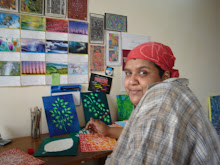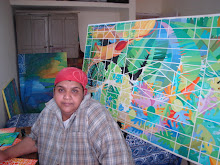
I have been fascinated with resist techniques like Batik for a long time.
Batik Design from Ghana, Africa
 This popular resist technique is known to be more than a millennium old and probably originates in ancient Egypt or Sumeria as historical evidence points out. Batik is found in several countries in West Africa such as Nigeria, Mali, Ghana and Cameroon, and in Asia in countries such as India, Sri Lanka, Bangladesh, Iran, Thailand, Malaysia, and Indonesia.
This popular resist technique is known to be more than a millennium old and probably originates in ancient Egypt or Sumeria as historical evidence points out. Batik is found in several countries in West Africa such as Nigeria, Mali, Ghana and Cameroon, and in Asia in countries such as India, Sri Lanka, Bangladesh, Iran, Thailand, Malaysia, and Indonesia.Kawung Prabu Motif From Yogyakarta, Indonesia
 Batik is an Indonesian word and refers to a generic wax-resist dyeing technique used on textile. The word originates from Javanese words "amba", meaning ”to write” and dot or point, "titik".The art of Batik reached its highest achievement in technique, intricate design, and refined aesthetic in Java, Indonesia. The island of Java has been well known for its exquisite batik for centuries, particularly in places such as Yogyakarta, Pekalongan, Cirebon, and Solo.
Batik is an Indonesian word and refers to a generic wax-resist dyeing technique used on textile. The word originates from Javanese words "amba", meaning ”to write” and dot or point, "titik".The art of Batik reached its highest achievement in technique, intricate design, and refined aesthetic in Java, Indonesia. The island of Java has been well known for its exquisite batik for centuries, particularly in places such as Yogyakarta, Pekalongan, Cirebon, and Solo. Batik from Madhya Pradesh, India
 Melted wax is applied to cloth before being dipped in dye. A mixture of bees wax and paraffin wax is used. The bee's wax will hold to the fabric and the paraffin wax will allow cracking, which is a characteristic of batik. Wherever the wax has seeped through the fabric, the dye will not penetrate. Thin wax lines are made with a canting needle, a wooden handled tool with a tiny metal cup with a tiny spout, out of which the wax seeps. Other methods of applying the wax onto the fabric include pouring the liquid wax, painting the wax on with a brush, and applying the hot wax to precarved wooden or metal wire block and stamping the fabric.
Melted wax is applied to cloth before being dipped in dye. A mixture of bees wax and paraffin wax is used. The bee's wax will hold to the fabric and the paraffin wax will allow cracking, which is a characteristic of batik. Wherever the wax has seeped through the fabric, the dye will not penetrate. Thin wax lines are made with a canting needle, a wooden handled tool with a tiny metal cup with a tiny spout, out of which the wax seeps. Other methods of applying the wax onto the fabric include pouring the liquid wax, painting the wax on with a brush, and applying the hot wax to precarved wooden or metal wire block and stamping the fabric.Hawaiian Batik Design
 Sometimes several colors are used, with a series of dyeing, drying and waxing steps.
Sometimes several colors are used, with a series of dyeing, drying and waxing steps.After the last dyeing, the fabric is hung up to dry. Then it is dipped in a solvent to dissolve the wax, or ironed between paper towels or newspapers to absorb the wax and reveal the deep rich colors and the fine crinkle lines that give batik its character.
Contemporary Batik
Contemporary batik, while owing much to the past, is markedly different from the more traditional and formal styles. For example, the artist may use etching, discharge dyeing, stencils, different tools for waxing and dyeing, wax recipes with different resist values and work with silk, cotton, wool, leather, paper or even wood and ceramics.
Caribbean Batik Art
from Guadeloupe
 Batik Silk Landscape
Batik Silk Landscape
......and so I decided to do my own experiments. In 1987 while working for an advertising agency I discovered how to manipulate Cow Gum (brand name) or rubber cement/solution (as it is popularly known)in place of wax to get a wonderful resist technique that would resemble contemporary Batik methods. I have used drawing ink on paper.
In 2006 I did the following abstracts.
SUN

WATER

JUNGLE

SPRINGSCAPE

AUTUMN LEAVES

BAMBOO GROVE

CITY SCAPE

AUTUMN GROUNDS



3 comments:
Hi Sanchita,
I hhave grown up watching my mom sitting by a molten wax cup and drums of colors...obviously as you have guessed doing batik. Its really an all time favorite art form and I remember this four galloping horses in four splendid colors in our dining room.
But I have to say that I am so amazed by the substitute you have used here for wax. And how do I even comment on your art? Its as beautiful as it can get. I love the bamboo grove and the jungle!!
Keep up your great work Sanchita and do keep me posted with your latest work. Take care.
wow! what a great amount of information you have on batik- even if gathered over time. but i am bowled over by this collection from so many parts of the world. of course once again touched by your depth and eye for detail.
Hi Sanchita
Thank you for your kind comments on my blog, I am glad you find it interesting.
I like your Cow Gum batiks, the sun one is beautiful and mesmerising.
best wishes
Alastair McGowan
Post a Comment